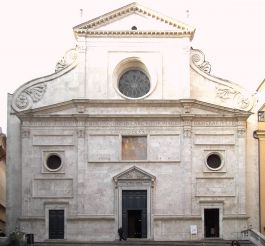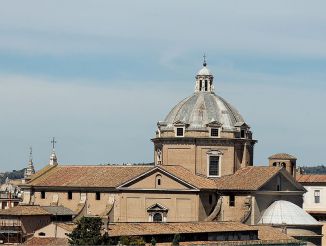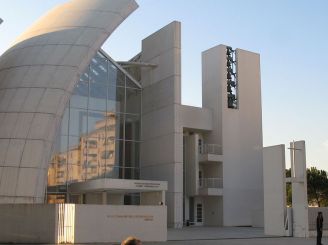Basilica of Sant' Agostino, Rome

Basilica of Sant' Agostino (Chiesa di Sant’Agostino) is a small temple in Rome. It is one of the very first basilicas of the Renaissance. The most famous masters of the Renaissance were engaged in its decoration. The architects borrowed materials from the Colosseum itself for the construction.
History of the church
The creation of the temple dates back to the end of the 14th century, when the Augustinian monks decided to build a new church for their monastery. Construction ended in 1420, but it was unsuccessful. The building came out too small and was often subjected to flooding of the Tiber River.
In 1479, Cardinal Guillaume d'Estouteville, better known as the Archbishop of Rouen, provided financing for the construction of a new church building. The project was created by architect Leon Battista Alberti, and the work was led by Jacopo da Pietrasanta. In 1483 the church was finished and consecrated, and on April 13, 1587 it acquired the present name – Sant'Agostino. In October 1999, Pope John Paul II elevated it to the rank of a small basilica.
Architecture and interior
- The façade of the church is made of rough blocks of gray marble and travertine. They were literally broken from the walls of the Colosseum.
- From the outside, the temple is quite small and devoid of significant decorations. But inside the builders did something weird with the space, and it seems a lot bigger than it actually is.
- The church has 3 naves, separated by pillars. In the side naves there are 5 chapels, another 4 chapels surround the altar and the apse.
- In the church there is a particularly revered tomb with the relics of St. Monica, mother of St. Augustine. In addition to her, the writer Maffeo Vegio, Cardinal Egidio da Viterbo and Countess Lorenzo de 'Medici are buried here.
- The marble altar is complemented by beautiful statues of the Virgin Mary by Jacopo and Andrea Sansovino.
- The church is decorated with works of famous artists of the Renaissance Guercino and Raphael.
- The basilica also has a real masterpiece, the famous work – Madonna di Loreto by Caravaggio.
Interesting fact
Caravaggio sketched Madonna di Loreto from the very unusual model. The fact is that the artist used a courtesan as a model. As a result, the Madonna in the picture received a sufficiently deep cleavage to disturb the clergy to the boiling point. Also, the Magi on the canvas are depicted with dirty, cracked feet, which in those days was considered very bad thing. This fact also did not please either the religious elite or the colleagues of the artist and caused a strong reaction.
Why did Caravaggio use the courtesan to portray the image of the mother of Jesus? It is simple, because the model was one of the parishioners of the church. The fact is that at first the temple was visited mostly by the queens of the night. Whether in order to atone for sins, or after the birth of a child. It is known that among the attendees there were only elite and expensive representatives of the oldest profession who served high-ranking officials and even the clergy. And in order for other parishioners not to get distracted by the charms of women, the latter had their place on the front benches.
How to get there
The Roman Basilica of Sant' Agostino is located in the historical center, near the eastern bank of the Tiber River, on the Piazza di S. Agostino. Not far from it there are the Palazzo Pamphilj and Altemps, the Napoleonic Museum and the beautiful Piazza Navona. In 100 meters there is the Senato bus stop (routes 30, 70, 81, 87, 130F, 492, 628, N6, N7).
Opening hours: every day from 7:30 to 12:00 and from 16:00 to 19:00. For detailed information about the visit, you can call (+39) 06 68801962.
Free admission.



_September_2015-1.jpg)


